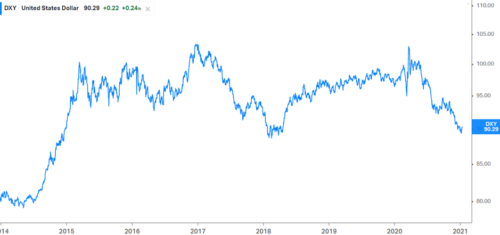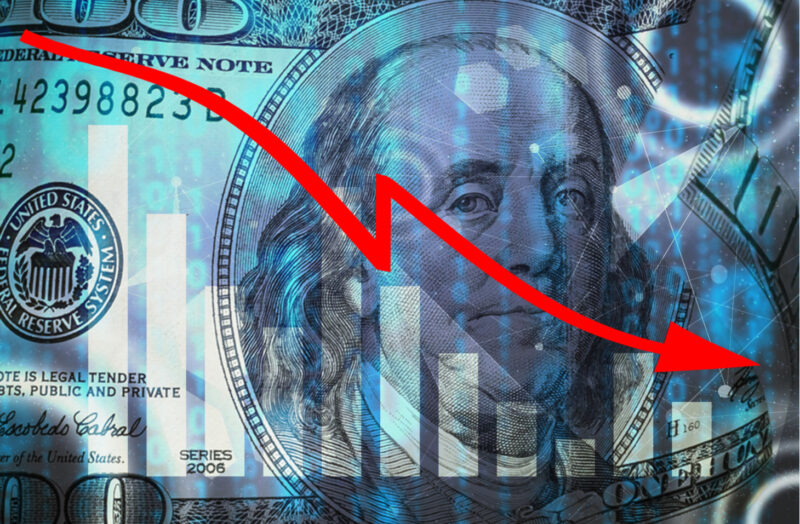What if the number of millimetres in a centimetre kept changing?
Ah, Nigel won’t like that…
What if the number of… erm… quarter inches in an inch kept changing?
One day it’s four, the next it’s five. Next year it’ll go down to three.
It’d make life very confusing, wouldn’t it? And life is plenty confusing as it is.
Especially because the financial market equivalent of an inch does keep changing its value. The value of our money.
I don’t just mean inflation here. Although that is an important point.
The fact that the value of our money changes each year is problematic for anyone trying to make long-term plans. We don’t know what sort of burden our mortgage might be in a few years’ time, nor the value of our savings. Is a 2% return good, or 7%? It depends on unpredictable inflation.
And yet, that’s what central banks try to do. Reduce the value of money at a few per cent a year. And they’re not very good at hitting their targets.
But my point today is about the unit of measurement which the world uses in every financial transaction. Even though we are very rarely aware of it.
That unit of measurement is the US dollar.
They’re your dollars too
I know you probably don’t use the US dollar in your everyday transactions. But most large businesses whose goods you are buying probably do.
You see, most international trade is conducted in US dollars, even between countries using other currencies.
The Bank for International Settlements (BIS) estimated in 2016 that over 80% of global trade involved US dollars. Imagine how high it was before the euro…
How does this work in practice? Well, an example is rather instructive.
In 2012 the Copenhagen Post reported that US authorities had confiscated and kept US$20,000 of a Danish policeman’s money because he tried to buy Cuban cigars from Germany.
You might think this transaction has nothing to do with the US, let alone its currency, so how did they even get the money, let alone find out about it, or keep the funds?
Well, the transaction flowed via the US dollar and the US payment systems. As do most international transactions, especially between businesses. And that allowed the US to freeze the funds. Despite the transaction being legal in Denmark and Germany.
A more common example is that commodities are usually priced in US dollars. And then converted to local currencies at prevailing exchange rates. Even the London Bullion Market Association sets its gold price in dollars, not pounds.
The growing and shrinking yardstick
But the US dollar’s value isn’t fixed. It changes, every day. Every split second, even.
This means that the price of everything is in effect moving at all times because the unit of measurement is changing. People presume that the price of gold, Cuban cigars and lunch is what’s fluctuating. But what happens when the US dollar is what’s on the move instead?
International Monetary Fund research from 2017 suggests that a rising US dollar drags down international trade. More specifically, a 1% rise in the US dollar against all other currencies in the world predicted a global trade reduction of between 0.6% to 0.8%.
That’s because, when US dollars become more expensive for people conducting trade, it means everything they want to buy on global markets has become more expensive too. That’s all commodities. And all contracts written in US dollar prices. Not to mention debt denominated in US dollars, which many corporations issue, despite being based outside the US.
Here’s a chart of the Dixie – the US dollar index. It compares the US dollar’s exchange rate with a number of different currencies to try and get at the US dollar’s changing value instead of the changing value of the other currencies. Think of it as the value of the US dollar.
 Source: Koyfin
Source: Koyfin
As you can see, it has been going sideways in a range since 2015.
In March 2020, the US dollar spiked as the Covid-19 panic hit. And it has recently ticked up from near its lows going right back to 2015. That last uptick is why I’m writing this today. It got our attention.
Could the Dixie surge again? Back to the top of the range?
That’s the big risk I want you to become aware of today. A bit of trouble in financial markets and trade because of a rising US dollar – something most people won’t even be aware of when it happens. Let alone expect the implications…
When there’s a crisis, the world rushes to the safety of the US dollar. It’s become a bit of knee-jerk reaction. But this makes crises worse by interfering with the price of everything. As mentioned a second ago, a higher US dollar tightens trade and makes things more expensive for the world.
This means it pays to keep one eye on the Dixie at all times. Plenty of traders I know check it first thing in the morning. It is, after all, in a way, the price of everything. Perhaps all the other moves in financial markets can be explained by that single indicator – the change in the unit of measurement, the US dollar.
Why did the US dollar suddenly surge last week?
That’s easy. US interest rates hit 1%. Which seems to have been a psychological barrier for the US dollar to attract some interest again, pun intended.
Do you see the sudden surge over the last few days in this chart?
 Source: Koyfin
Source: Koyfin
We’re not talking about central bank interest rates here. I’m talking about US government bonds.
The ten-year bond doubled its yield from half a per cent to over one per cent since August. It now costs the US government twice as much to borrow money. And investors get twice as much return. That makes US dollars a lot more attractive. And the added demand spiked the US dollar’s value on foreign exchange markets.
The point is that we need to keep an eye on this trend. It’s a bit like a builder keeping an eye on their blueprint as the increasingly growing inch causes trouble on the building site. Not that the building profession would put up with this sort of thing…
I know Nigel is keeping an eye on the dollar. He mentioned it in our call.
As a former commodity trader, that’s hardly a surprise. I’ve asked him to record a quick video to explain his take on what’s going on.

Nick Hubble
Editor, Fortune & Freedom



